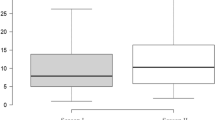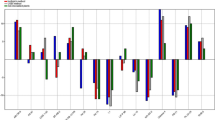Summary
The object of this work was a study of the relationship between the field reactions of different sunflower genotypes to basal stalk rot (in terms of severe (dead plants) and incipient wilting, and lesion length) and some biochemical (phenol concentration), morphological (plant height, and stem and flower-bud diameters) and anatomical (xylem and cortical indexes) characters of the host. Plants from 8 inbred lines at closed flower-bud stage were artificially inoculated with mycelium at the base of the stem. The percentage of dead plants for each inbred line and the lesion length and wilting range for individual plants after 7 days were recorded.
A positive and highly significant correlation coefficient between the percentage of dead plants and lesion length was found for the three years of the study (r=0.83; P<0.01). A highly significant association between lesion length and wilting range for individual plants was always found (P=0.00). Postinfectional phenol content exhibited a strong negative correlation with lesion length and the percentage of dead plants in all the experiments (P=0.05). Association between postinfectional phenol content and wilting range for individual plants was significant for all the years studied (P<0.05). No correlation between phenol levels in healthy plants of the different sunflower genotypes and their susceptibility was found. Morphological characters positively correlated with lesion length but only plant height exhibited significant values for the three years. Associations between wilting range and morphological characters for individual plants were significant for one of the two years analyzed (P<0.05). Xylem index showed a negative correlation with lesion length which was significant one of the two years studied.
The lesion length measure seems to be a simple and direct method for resistance screening before the flowering period. Although strong relations with postinfectional phenol levels were found, their determinations would be too much time consuming and not completely reliable. The relationships between other characters measured and disease resistance would indicate that physiological mechanisms could be related to resistance.
Similar content being viewed by others
References
Auger, J.S. & F.H., Nome, 1970. Efecto de la edad en la predisposición de la Maravilla (Helianthus annuus L.) a la esclerotiniosis (Sclerotinia sclerotiorum (Lib.) de Bary). Agr. Técnica. 30(3): 161–165.
Bateman, D.F., 1978. The dynamic nature of disease. In: J.G., Horsfall & E.B., Cowling (Eds). Plant Disease: An Advanced Treatrise, Vol. 3, p. 53–83. Academic Press, New York.
Bazzalo, M.E., 1986. Mecanismos de defensa en Heliantus annuus L. frente al ataque del hongo Sclerotinia sclerotiorum (Lib.) de Bary. Doctoral Thesis. Facultad de Ciencias Exactas y naturales. Universidad de Buenos Aires, Argentina.
Bazzalo, M.E., E., Heber, M.A., Del, Pero de Martines & O.H., Caso, 1985. Phenolic compounds in stems of sunflower plants inoculated with Sclerotinia sclerotiorum and their inhibitory effects on the fungus. Phytopath. Z. 112: 322–332.
Bazzalo, M.E., E., Heber & O.H., Caso, 1987a. Factores físicos y localización anatómica de compuestos fenólicos en relación con la tolerancia del tallo del girasol (Helianthus annuus) frente a Sclerotinia sclerotiorum, causal de la podredumbre basal. Boletín de la Sociedad Argentina de Botánica 25 (1–2): 197–212.
Bazzalo, M.E. & P. Dimarco, 1987b. Correlación entre la susceptibilidad de Helianthus annuus a la podredumbre basal (Sclerotinia sclerotiorum) y algunas variables morfológicas y bioquímicas de la planta. Proc. V. Reunión Técnica Nacional de Girasol. p. 117–124. Bahia Blanca, Argentina.
Bray, H.G. & W.V., Thorpe, 1954. Analysis of phenolic compounds of interest in metabolism. Methods Biochem. Anal. 1: 27–52.
Brigham, R.D., 1988. Twenty years of sunflower (Helianthus annuus L.) releases in the U.S.A. Proc. XII Intern. Sunflower Conference, p. 398–403. Novi Sad, Yugoslavia.
Dorrell, D.G. & H.C., Huang, 1978. Influence of Sclerotinia wilt on seed yield and quality of Sunflower wilted at different stages of development. Crop Sci. 18: 974–978.
Falconer, D.S., 1960. Introduction to quantitative genetics. Oliver & Boyd. Edimburgo.
Friend, J., 1976. Lignification in infected tissue. In: J., Friend & D.R., Threlfall (Eds). Biochemical aspects of Plant Parasite Relationships. Academic Press, New York.
Gulya, T.J., 1985. Evaluation of sunflower germplasm for resistance to Sclerotinia stalk rot and race 3 Downy Mildew. In Proc. XI Intern. Sunflower Conference, p. 349–352. Mar del Plata, Argentina.
Hall, A.B., V., Blum & R.C., Fites, 1982. Stress modification of allelopathy of Helianthus annuus L. debris on seed germination. A.J. Bot. 69(5): 776–783.
Huang, H.C. & W., Dedio, 1982. Registration of CM 497 and CM 526 sunflower parental lines. Crop. Sci. 22: 166.
Kolte, S.J., B., Singh & A.N., Tewari, 1976. Evaluation of sunflower genotypes for resistance to Sclerotinia sclerotiorum. Indian. J. Mycol. Plant Pathol. 6: 65–67.
Lumsden, R.D., 1979. Histology and physiology of Pathogenesis in plant diseases caused by Sclerotinia species. Phytopath. 69: 890–896.
Martinson, C.A., F.J. Avila, Z.B. Yang & C.J. Daugherty, 1988. Phytoalexin type response to sunflower stems to Sclerotinia sclerotiorum. Proc. XII Intern. Sunflower Conference. p. 582–586. Novi Sad, Yugoslavia.
Noyes, R.D. & J.G., Hancock, 1981. Role of oxalic acid in the Sclerotinia wilt of sunflower. Physiol. Plant Pathol. 18: 123–132.
Orellana, R.G., 1975. Photoperiod influence on the susceptibility of sunflower to Sclerotinia stalk rot. Phytopath. 65: 1293–1298.
Pawloski, S.H. & E.J., Hawn, 1964. Host-parasite relationships in sunflower wilt incited by Sclerotinia sclerotiorum as determined by the twin technique. Phytopath. 54(1): 33–35.
Sedun, F.S. & J.F., Brown, 1989. Comparison of three methods to assess resistance in sunflower to basal stem rot caused by Sclerotinia sclerotiorum and S. minor. Plant Dis. 73: 52–55.
Sokal, R.R. & F.L., Rohlf, 1979. Biometría. H. Blume Publishers. Madrid.
Steel, R.G.D. & J.H., Torrie, 1980. Principles and procedures of statistics. A biometrical approach. McGraw-Hill. Inc. New York.
Thompson, T.E., C.E. Rogers, D.C. Zimmerman, E.D.P. Whelan & J.F. Miller, 1978. Evaluation of Helianthus species for disease resistance and oil content and quality. Proc. VIII Intern. Sunflower Conference. P. 501–506. Minneapolis, Minnesota, U.S.A.
Wink, M., 1988. Plant breeding: importance of plant secondary metabolites for protection against pathogens and herbivores. Theor. Appl. Genet. 75: 225–233.
Author information
Authors and Affiliations
Rights and permissions
About this article
Cite this article
Bazzalo, M.E., Dimarco, P., Martinez, F. et al. Indicators of resistance of sunflower plant to basal stalk rot (Sclerotinia sclerotiorum): Symptomatological, biochemical, anatomical, and morphological characters of the host. Euphytica 57, 195–205 (1991). https://doi.org/10.1007/BF00039666
Received:
Accepted:
Issue Date:
DOI: https://doi.org/10.1007/BF00039666




